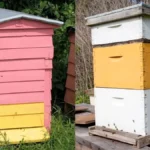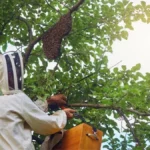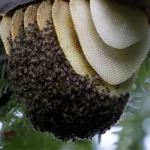I am a beekeeper and in my twenty-five years of beekeeping, I have removed wild honeybee hives from some amazing places and learnt what a wild honeybee hive looks like and how it fits together. In this article, we will look at what a honey bee hive looks like, where do honey bees nest. And after having a look at the basic structure of a wild hive, we will then delve into how, as humans, we can make it easy to work with the bees in a modern honeybee beehive, and explore what this hive looks like.
Honeybees nest in a honeybee hive where they run their amazing society and build combs to process flower and plant resources.
To understand what a honeybee hive looks like we need to understand the types of hives that exist, and why they look the way they do.
Where Do Honey Bees Nest in The Wild?
A wild swarm of bees evaluates available nest options to choose a space offering protection from the weather. Consequently, bees can choose pretty unusual places to nest. I have removed wild beehives from holes in the ground, caves, hollow trees, old barrels/drums, compost makers, worm bins, post boxes, cell phone mast towers, military tanks, old tyres, cars, fire engines and a jet aircraft amongst others.
In Zambia, Florida, the Congo and Brazil I have even seen bees make nests hanging from branches. For shelter, these bees build a layer of wax and propolis over the hive, and because they are not in a cavity, these bees are more aggressive.

Learn more about: Do Bees Have Compound Eyes?
Where Do Honey Bees Nest In Manmade Hives?
Simple Constructed Beehives:
The simplest man-made beehives are just a container, such as a clay pot, woven basket (A skep hive), wooden box, or hollowed-out tree (bee gum). There is no human organised structure to these hives. Consequentially these hives are inefficient because working with the bees permanently damages the hive.
Advanced Constructed Beehives:
The Reverend Langstroth invented the modern revolutionary beehive in 1852. The main improvement in this beehive is the moveable frames in which the bees build combs. The magic formula for the Langstroth hive employs “bee space” to ensure that bees do not glue the inside of the hive into an unworkable mess. This beehive forms the backbone of the modern global bee industry because it allows us to manipulate bees and make the hive more efficient than a wild beehive.
What Is Bee Space?
Bee space is that space that bees will not fill with a comb. The distance between the surface of two combs in a beehive is called bee space. Bee space is about 5/16th of an inch (8mm) but varies a bit depending on the race of the bee. For a bee, any space too small to crawl into is a place where pests can hide -the bees seal these spaces off with propolis. If the space is large enough for them to crawl through, but not enough space to build a comb, they leave it as is. If the space is big enough they build a comb. Bee space is the reason a honeybee nest looks the way it does in the wild.
What Is The Structure of A Honeybee Nest?
The basic structure of a wild honeybee nest is a series of combs spaced using bee space. We use bee space to get the bees to build their combs on removable frames. The frame supports the comb and makes it stronger.
Brood Nest Area
In a wild hive, the combs in the middle of the hive contain brood-bee eggs, larvae and pupae. This is where the queen lays eggs producing the next generation of bees. Workers feed developing bees in the brood nest.
Pollen Processing Area
Pollen filled combs are on each side of the brood nest. Workers process pollen into bee bread. This is a nutritious protein, lipid and vitamin-rich food that nourishes the hive.
Honey Processing and Storage Area
Next to the pollen combs, we find the area where bees convert nectar from flowers into honey. Complicated sugars in nectar are enzymatically converted to simple sugars. This processed nectar is then dried. Once it contains about 80-83% sugar by weight we call it honey. Honey is sealed in the comb to exclude moisture. This honey can be stored for long periods.
What Does A Modern Honey Bee Hive Look Like?
In a modern beehive, bees build combs in moveable frames that we design using bee space and arranged in a bee space compliant box called a beehive. Conveniently, the boxes are stackable and easy to transport. As a result, it is possible to pack modern beehives in their thousands on semi-trucks and trailers and migrate hundreds of miles from one crop needing pollination to another.
Modern beehives boxes can be made from wood or composite plastic materials. Some hives are even made from cement in areas where bears vandalise other hives.
The Structure Of A Modern Honey Beehive:
Brood Box
The first and in some cases second box of the hive is the brood box. This is where the bees keep the brood nest, pollen and a little honey “working capital”. Generally, a brood box is a deep box, which is 9 9⁄16 inches (243 mm) deep. Because brood is not heavy we can use these big boxes for the brood nest. Consequently, there is enough space on the big frames for the queen to wander around easily and lay lots of eggs. She can lay 2000-4000 eggs a day depending on her genetics. However, as beekeepers, we need to work with her to give her the space to do her job quickly and efficiently because time is honey.
Honey Supers
Honey Supers are short for Honey Superstructures. Some people call these honey Supas. Honey supers are boxes placed above the brood nest where the bees are encouraged to store honey. Therefore this organisation makes harvesting honey much less complicated.
With regards to honey supers, there are two types of beekeepers. The first type of beekeepers will suffer back problems later in life and use heavy deep boxes as honey supers. The second type uses shallow supers which are lighter, and consequently easier to carry and do not cause long term back damage. Because I am now an older beekeeper of the first type I wish I had used shallow supers when I was younger.
Read more about: How to Ventilate a Beehive
What Does A Complete Modern Beehive Look Like?
Because many beekeepers are colourful characters they often paint their hives different colours. Some beekeepers like their beehives to be plain white, or wood coloured boxes. The bees don’t care.
Typically a beehive comprises one or two deep boxes and honey supers stacked on top of that. In exceptional years, when we have large amounts of flowers, a beehive can consist of two brood boxes and as many as ten honey supers. This structure looks more like a skyscraper than a beehive. The activity of bees working a big hive like this is truly amazing.
I have seen one hive like this that was covered in bees for a season. This hive produced more than a ton of honey and was so aggressive it would start to sting us from 50 feet away from the hive. Luckily, normal beehives are generally much less scary and sadly do not produce a ton of honey a year.
If this article helped you learn more about what a beehive looks like please share it with your friends. The more of us that know about bees, the better.

Dr. Garth A. Cambray is a Canadian/South African entrepreneur and beekeeper with 28 years of experience in apiculture and specializes in adding value to honey. His Ph.D. research developed a new advanced continuous fermentation method for making mead that has resulted in a number of companies globally being able to access markets for mead. His company, Makana Meadery, exports honey mead to the USA where it is available to discerning connoisseurs. He has also developed technologies to commercially manufacture organic honey vinegar in Zambia for export globally. He holds a few patents globally in the ethanol industry and believes in technology and knowledge transfer for human development and environmental sustainability. One of his proudest achievements is the fact that the wind farm he started at one of his old apiary sites has essentially made his hometown carbon neutral.






